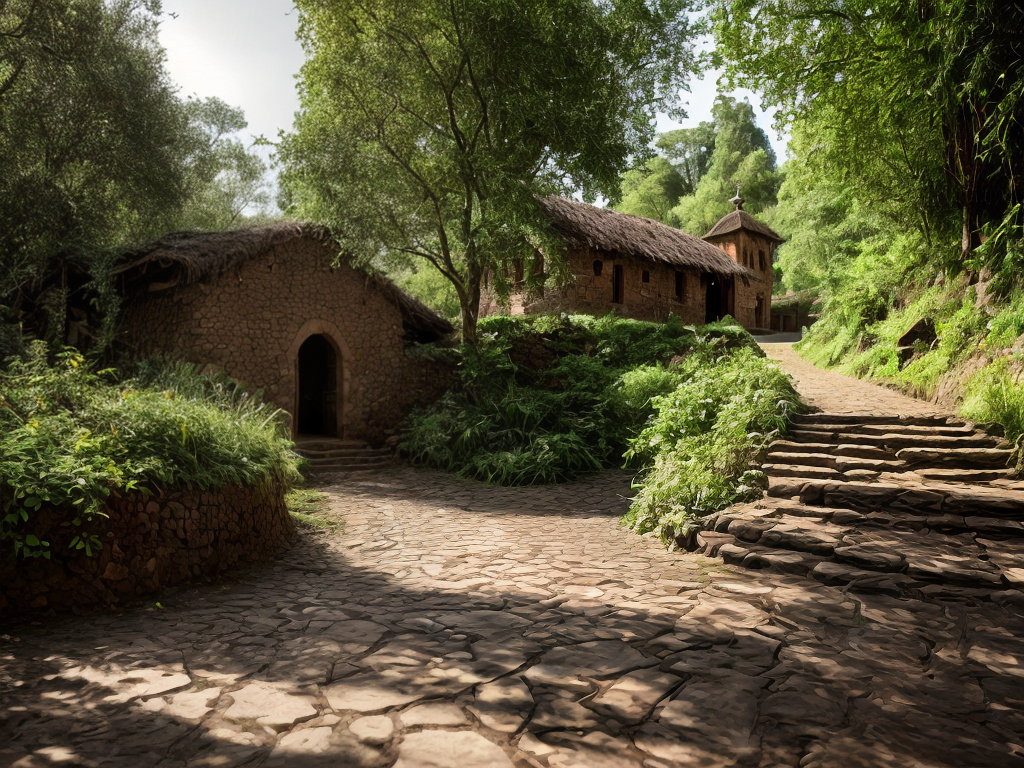Like a passport that opens the door to a vibrant new world, cultural immersion allows me to step into the heart of a community and experience its traditions and festivities firsthand. Exploring local traditions is like unraveling the threads of a rich tapestry, each tradition painting a picture of a unique culture. From vibrant festivals and captivating music and dance performances to indulging in the flavors of traditional cuisine and learning ancient handicraft techniques, cultural immersion offers a kaleidoscope of experiences. But there is so much more to discover beyond the surface. It is through community service projects, traditional healing practices, language and communication, and the intimate embrace of homestays and cultural immersion programs that the true essence of a culture is revealed. So, come with me on this journey as we dive into the depths of cultural immersion and uncover the treasures that await.
Exploring Local Traditions
When exploring local traditions, I immerse myself in the rich cultural heritage of the community. One of the most captivating aspects of this immersion is experiencing traditional festivals and witnessing indigenous customs. These events provide a unique opportunity to connect with the local community and gain a deeper understanding of their customs and beliefs.
Traditional festivals are an integral part of the cultural fabric of a community. They serve as a time for celebration, honoring historical events, and paying homage to ancestral traditions. Whether it’s the vibrant colors of a carnival or the rhythmic beats of a traditional dance, these festivals showcase the unique identity of a community. Participating in these festivities allows me to witness the pride and joy that the locals feel for their heritage.
Indigenous customs, on the other hand, offer a glimpse into the ancient practices and rituals of a community. From sacred ceremonies to traditional craftsmanship, these customs provide insight into the beliefs and values that have been passed down through generations. By observing and even partaking in these customs, I feel a sense of connection to the past and a deep appreciation for the wisdom and knowledge that has been preserved.
Exploring local traditions, including traditional festivals and indigenous customs, allows me to immerse myself in the heart of a community’s cultural heritage. It is through these experiences that I gain a greater appreciation for the diversity and richness of human culture. Each festival and custom I witness becomes a cherished memory, fostering a sense of intimacy and connection with the community I am privileged to experience.
Festivals and Celebrations
Participating in local festivals and celebrations allows me to fully immerse myself in the vibrant traditions of the community. It is during these festive events that I witness the true essence of the culture and experience firsthand the rich heritage of the people. Here are four remarkable aspects that make festivals and celebrations an integral part of cultural immersion:
-
Diverse Traditions: Festivals and celebrations showcase the diversity of traditions within a community. From religious ceremonies to harvest festivals, each event offers a unique insight into the customs and beliefs that have been passed down through generations.
-
Colorful Displays: The vibrant decorations and costumes worn during festivals create an enchanting atmosphere. Splashes of bright hues and intricate patterns adorn the streets, bringing life and energy to the festivities. It is truly a visual feast for the senses.
-
Traditional Performances: Festivals often feature traditional music, dance, and theater performances. These artistic expressions offer a glimpse into the cultural heritage and storytelling traditions of the community. Through these performances, I feel a deep connection to the history and values of the people.
-
Traditional Healing Practices: Some festivals incorporate traditional healing practices, providing a unique opportunity to witness ancient healing rituals. From herbal remedies to energy balancing techniques, these practices offer insight into alternative healthcare systems and the importance of holistic well-being.
Participating in local festivals and celebrations not only allows me to celebrate alongside the community but also provides a deeper understanding and appreciation of their cultural heritage. It is through these shared experiences that I truly feel connected to the people and their traditions.
Traditional Music and Dance
Traditional music and dance play a significant role in immersing myself in the local culture and connecting with the rich heritage of the community. Participating in traditional dance workshops and attending music festivals allows me to experience the authentic rhythms and movements that have been passed down through generations.
When I join a traditional dance workshop, I am able to learn the intricate steps and gestures that are unique to the local culture. The instructors, often seasoned dancers themselves, guide me through the process of mastering the traditional dance forms. Through their expertise and patience, I am able to appreciate the complexity and beauty of these dances.
Attending music festivals is another way for me to fully immerse myself in the local music scene. These festivals showcase a diverse range of traditional music performances, from lively folk tunes to soulful ballads. The atmosphere is filled with energy and excitement as musicians and performers come together to celebrate their cultural heritage.
During these festivals, I have the opportunity to witness traditional musical instruments being played with skill and passion. The melodies and harmonies created by these instruments transport me to a different time and place, allowing me to feel a deep connection to the community’s roots.
Culinary Experiences
As I engage in the local traditions and festivities, my exploration extends beyond music and dance to encompass the delightful realm of culinary experiences. Immersing myself in the local cuisine allows me to truly understand and appreciate the culture and traditions of the community I am visiting. Here are four culinary experiences that have left a lasting impression on me:
-
Cooking Classes: Participating in cooking classes has been a highlight of my cultural immersion journey. Not only do I get to learn the secrets of traditional recipes from local chefs, but I also get a hands-on experience in preparing the dishes myself. From mastering the art of making homemade pasta in Italy to crafting the perfect sushi roll in Japan, these classes have provided me with valuable skills and insights into the local culinary traditions.
-
Street Food Tasting: Exploring the vibrant street food scene has been an adventure for my taste buds. From savoring aromatic spices in the bustling markets of India to indulging in mouthwatering tacos from food stalls in Mexico, street food offers a unique glimpse into the authentic flavors of a culture. It allows me to interact with local vendors, hear their stories, and try a wide variety of dishes that I might not find in traditional restaurants.
-
Farm-to-Table Experiences: Engaging in farm-to-table experiences has given me a deeper appreciation for the connection between food and nature. Visiting local farms and participating in activities such as harvesting fresh produce, milking cows, or gathering eggs has allowed me to understand the importance of sustainable farming practices and the impact they have on the food we consume.
-
Traditional Food Festivals: Attending traditional food festivals has been a feast for both the senses and the soul. From vibrant celebrations of local delicacies to cultural performances and lively music, these festivals showcase the rich culinary heritage of a community. Whether it’s the colorful Holi festival in India or the lively Oktoberfest in Germany, these events offer a unique opportunity to sample a wide variety of traditional dishes and experience the joy and camaraderie that comes with sharing a meal with locals.
Culinary experiences have undoubtedly been a significant part of my cultural immersion journey. Through cooking classes, street food tasting, farm-to-table experiences, and traditional food festivals, I have not only expanded my culinary knowledge but also deepened my understanding and appreciation of the local culture and traditions.
Handicraft Workshops
One fascinating aspect of immersing myself in the local traditions and festivities is the opportunity to engage in handicraft workshops. These workshops provide a unique chance to learn and create traditional crafts in an artistic setting. Participating in these workshops allows me to gain a deeper understanding of the local culture and its rich artistic heritage.
In these workshops, I have the opportunity to learn from skilled artisans who have mastered their crafts over generations. They patiently guide me through the process, teaching me the techniques and sharing their knowledge and expertise. It is truly a privilege to be able to learn from these talented individuals and to witness their passion for their craft.
The workshops cover a wide range of traditional crafts, including pottery, weaving, wood carving, and painting. Each craft has its own unique history and significance within the local culture. By participating in these workshops, I not only learn the technical skills involved in creating these crafts but also gain a deeper appreciation for the cultural significance and symbolism behind each piece.
The artistic workshops foster a sense of creativity and self-expression. They provide a space for me to explore my own artistic abilities and to create something with my own hands. It is a deeply fulfilling experience to see my creations take shape and to know that I have contributed to preserving and promoting the local artistic heritage.
Religious Ceremonies
Engaging in handicraft workshops not only allows me to explore the local artistic heritage, but it also paves the way for a deeper understanding and participation in the religious ceremonies of the community. The religious rituals and sacred ceremonies provide a glimpse into the spiritual beliefs and practices of the locals, allowing me to connect with their culture on a profound level. Here are four ways in which I have been able to immerse myself in the religious ceremonies of the community:
-
Attending religious processions: These processions are an integral part of the community’s religious celebrations. By joining these processions, I am able to witness the devotion and reverence of the locals as they carry religious icons through the streets, accompanied by traditional music and dance.
-
Participating in prayer and meditation sessions: The community often gathers together for prayer and meditation sessions at religious temples or sacred sites. By joining these sessions, I am able to experience the peaceful and serene atmosphere, and gain a better understanding of the spiritual practices that are significant to the locals.
-
Observing traditional ceremonies: From birth to death, traditional ceremonies play a significant role in the community’s religious practices. By observing these ceremonies, I am able to witness the rituals and customs associated with different life stages, and gain insight into the community’s beliefs surrounding these important milestones.
-
Engaging in religious festivals: The community celebrates various religious festivals throughout the year. By actively participating in these festivals, I am able to witness the vibrant and colorful traditions, taste traditional food, and engage in activities that are considered sacred by the locals.
Through my involvement in these religious ceremonies, I have not only deepened my understanding of the community’s spiritual beliefs, but I have also formed meaningful connections with the locals, fostering a sense of intimacy and cultural exchange.
Costume and Fashion Shows
I have had the opportunity to witness captivating costume and fashion shows as part of my exploration of local traditions and festivities. These shows provide a fascinating glimpse into the fashion trends and historical costumes of the region.
Attending these shows is like stepping into a time machine, as the models showcase garments that reflect the styles of bygone eras. From the elegant and intricate attire of the Renaissance to the bold and vibrant outfits of the 1960s, each era is brought to life through the intricate details and craftsmanship of the costumes.
Fashion trends are ever-evolving, and these shows highlight the evolution of style over the years. It is interesting to see how different cultures and time periods have influenced fashion choices, creating a rich tapestry of diversity and creativity.
The models gracefully glide down the runway, their outfits telling stories of the past. Every stitch, every bead, and every accessory is meticulously crafted to recreate the essence of a specific era or cultural tradition. The attention to detail is truly remarkable, and it is evident that these costumes are created with immense passion and dedication.
As I watch these shows, I am not only entertained but also educated about the history and cultural significance of fashion. It is a visual feast for the eyes and a wonderful way to appreciate the artistry and craftsmanship that goes into creating these stunning costumes.
Attending costume and fashion shows has been a truly enriching experience, allowing me to immerse myself in the local traditions and festivities while gaining a deeper understanding of the fashion trends and historical costumes that have shaped our world.
Folklore and Storytelling
Folklore and storytelling play a vital role in preserving cultural heritage and passing down traditions from generation to generation. These timeless traditions provide a window into the rich history and beliefs of a community, allowing us to connect with the past and gain a deeper understanding of different cultures. Here are four reasons why folklore preservation and oral storytelling are so important:
-
Cultural Identity: Folklore and storytelling serve as a powerful expression of a community’s cultural identity. Through myths, legends, and folktales, we learn about the values, customs, and beliefs that shape a society. These stories help to create a sense of belonging and pride among community members, allowing them to celebrate and cherish their cultural heritage.
-
Knowledge Transmission: Oral storytelling is a means of transmitting knowledge and wisdom from one generation to the next. Through these stories, important lessons, historical events, and moral values are imparted to children and young adults. This oral tradition ensures that valuable knowledge and cultural practices are not lost over time.
-
Community Bonding: Folklore and storytelling bring communities together. Whether it’s gathering around a campfire or attending a storytelling event, these traditions foster a sense of unity and togetherness. They provide opportunities for people to connect, share experiences, and strengthen social bonds.
-
Creativity and Imagination: Folklore and storytelling ignite the imagination and stimulate creativity. They allow individuals to explore different perspectives, worlds, and characters. By engaging with these narratives, people can develop critical thinking skills, empathy, and cultural sensitivity.
Sports and Games
I am excited to explore the subtopic of Sports and Games in the context of local traditions and festivities. Traditional sports and games play a significant role in connecting communities and preserving cultural heritage. From intense local team rivalries to the unique spectator traditions and rituals, these activities showcase the passion and unity of the community.
Traditional Sports and Games
Participating in the vibrant local traditions and festivities, traditional sports and games hold a significant place in preserving cultural heritage and promoting community engagement. Here are four fascinating aspects of traditional sports and games that showcase the richness of indigenous traditions:
-
Physical prowess and skill: Traditional sports often require a high level of physical fitness and skill. From the fast-paced game of sepak takraw in Southeast Asia to the graceful art of capoeira in Brazil, these sports highlight the agility and strength of the participants.
-
Cultural significance: Traditional sports and games are deeply rooted in cultural beliefs and practices. They serve as a way to pass down ancestral knowledge and teachings to future generations, fostering a sense of identity and belonging.
-
Teamwork and cooperation: Many traditional sports emphasize teamwork and cooperation. Whether it’s the traditional Maori game of ki-o-rahi or the Native American game of lacrosse, these sports encourage collaboration and unity among participants.
-
Traditional board games: In addition to physical sports, traditional board games also play a vital role in preserving cultural heritage. Games like chess, mahjong, and mancala have been passed down through generations, providing entertainment while preserving history and traditions.
Local Team Rivalries
Preserving cultural heritage and promoting community engagement, traditional sports and games also give rise to intense local team rivalries that ignite passionate competition in the realm of sports and games. These rivalries create a sense of belonging and identity within the community, as fans passionately support their local teams. One aspect that adds to the excitement of these rivalries is the pre-match traditions that are unique to each team. These traditions often include rituals, chants, and gestures that are passed down from generation to generation. They serve to unite the fans and create an electric atmosphere before the game even begins. Attending a match and witnessing these pre-match traditions firsthand allows one to feel the energy and camaraderie that exists between the fans, making it an unforgettable experience.
Spectator Traditions and Rituals
What are some of the spectator traditions and rituals that enhance the experience of watching sports and games? Here are four traditions and rituals that can make the experience more exciting and memorable:
-
Chants and Cheers: Spectators often come up with creative chants and cheers to show support for their favorite teams. These chants not only create a sense of unity among the crowd but also add to the overall atmosphere of the event.
-
Mascots and Costumes: Many sports events feature mascots and fans dressed in elaborate costumes. These characters entertain the crowd, interact with spectators, and bring a sense of fun and excitement to the game.
-
Pre-game Rituals: Some sports events have pre-game rituals that are performed by players or even spectators. These rituals can vary from team to team or from culture to culture, adding a unique touch to the overall experience.
-
Post-game Celebrations: After a game, spectators often join in post-game celebrations, where they can mingle with players, exchange stories, and share their passion for the sport. These celebrations provide an opportunity for cultural exchanges and a chance to connect with fellow fans.
Cultural Exchanges
Cultural exchanges provide an opportunity for individuals to engage in the exchange of customs, traditions, and ideas between different communities. One of the most impactful ways to experience cultural exchanges is through the appreciation and participation in cultural performances and traditional art forms.
Attending cultural performances allows individuals to witness the beauty and richness of a community’s artistic expressions. Whether it’s a traditional dance, a musical performance, or a theatrical production, these performances offer a glimpse into the heart of a culture. The vibrant costumes, rhythmic movements, and soul-stirring melodies create a profound connection between the performers and the audience. As a spectator, I can’t help but be moved by the passion and dedication that goes into these artistic endeavors.
However, cultural exchanges go beyond mere observation. They also provide an opportunity for active participation in traditional art forms. Through workshops, classes, or even informal gatherings, individuals can learn the intricacies of a specific art form directly from the practitioners themselves. This hands-on experience allows for a deeper understanding of the culture, as well as the chance to develop new skills and talents.
Local Markets and Bazaars
Have you ever explored the vibrant array of local markets and bazaars? These bustling hubs offer a fascinating glimpse into the heart of a community, showcasing the unique flavors and traditions of a region. Here are four reasons why visiting local markets and bazaars is a must-do when immersing yourself in a new culture:
-
Artisan Craftsmanship: From intricate handmade textiles to delicate pottery, local markets and bazaars are a treasure trove of artisan craftsmanship. You can find one-of-a-kind pieces that reflect the rich cultural heritage of the area. Whether it’s a beautifully woven rug or a hand-carved wooden sculpture, these unique creations make for meaningful keepsakes and souvenirs.
-
Unique Local Produce: Local markets and bazaars are the perfect place to discover the flavors of a region. Here, you’ll find an abundance of fresh fruits, vegetables, and herbs that are specific to the area. Taste exotic spices, sample unusual fruits, and indulge in traditional dishes made with the finest local ingredients. It’s a culinary adventure like no other.
-
Cultural Exchange: Engaging with local vendors and artisans at markets and bazaars provides an opportunity for cultural exchange. Strike up a conversation, learn about their traditions and techniques, and gain insight into their way of life. It’s a chance to connect on a personal level and build bridges between cultures.
-
Support Local Economy: By shopping at local markets and bazaars, you directly contribute to the local economy. Your purchases help sustain traditional crafts and support local farmers and artisans. It’s a meaningful way to give back to the community while enjoying the unique offerings of the market.
Community Service Projects
Engaging in community service projects provides an opportunity to make a meaningful impact and contribute to the betterment of the local community. It allows individuals to come together, share their skills and time, and work towards a common goal of improving the lives of others. Community service projects offer a range of volunteer opportunities that cater to different interests and abilities. Whether it’s helping to build homes for the less fortunate, organizing food drives to combat hunger, or tutoring children in underprivileged communities, there are countless ways to get involved and make a difference.
To give you an idea of the diverse range of community service projects available, here is a table showcasing three examples:
| Project | Description |
|---|---|
| Habitat for Humanity | Assisting in building affordable housing |
| Food Bank Volunteering | Sorting and distributing food donations |
| Mentoring Program | Providing guidance and support to youth |
Traditional Healing Practices
Traditional healing practices play a significant role in many communities, offering alternative approaches to healthcare and wellness. These practices, rooted in ancient wisdom and passed down through generations, provide unique insights into the interconnectedness of the mind, body, and spirit. Here are four intriguing aspects of traditional healing practices that showcase their importance and effectiveness:
-
Indigenous Remedies: Traditional healers often rely on the use of indigenous remedies, consisting of plants, herbs, and other natural substances. These remedies have been used for centuries and are believed to possess medicinal properties that can treat various ailments. From soothing herbal teas to poultices and salves, indigenous remedies offer a holistic approach to healing that honors the power of nature.
-
Shamanic Practices: Shamanic practices are an integral part of traditional healing in many cultures. Shamans, regarded as spiritual guides and healers, use rituals, ceremonies, and trance-like states to connect with the spirit world. Through their journeys, they seek guidance and healing for individuals and communities. Shamanic practices help restore balance and harmony, addressing not only physical symptoms but also emotional and spiritual imbalances.
-
Energetic Healing: Traditional healing practices recognize the existence of energy fields within the body. Techniques such as acupuncture, reiki, and energy balancing aim to restore the flow of energy and remove blockages that may cause illness or discomfort. By harmonizing the body’s energy, these practices promote overall well-being and support the body’s natural healing processes.
-
Mind-Body Connection: Traditional healing practices emphasize the powerful connection between the mind and body. Practices like meditation, mindfulness, and visualization are used to promote relaxation, reduce stress, and enhance healing. By cultivating a positive mindset and addressing emotional and psychological aspects, these practices contribute to a holistic approach to health and well-being.
Traditional healing practices offer valuable insights and alternative approaches to healthcare and wellness. They provide a rich tapestry of knowledge and techniques that can complement modern medicine and support individuals on their healing journeys. Embracing these practices allows for a deeper understanding of ourselves and the world around us, fostering a sense of connectedness and wholeness.
Language and Communication
Language and communication play a vital role in facilitating understanding, fostering connections, and transmitting cultural knowledge within a community. When immersing oneself in a new culture, language learning becomes essential in breaking down cultural barriers and building intimate relationships with locals.
Learning the local language not only allows for basic communication but also opens doors to a deeper understanding of the culture. It enables us to engage in meaningful conversations, understand local customs and traditions, and appreciate the nuances of the community. By speaking the language, we show respect for the local culture and create a sense of belonging within the community.
However, language learning can be challenging, especially when faced with cultural barriers. Pronunciation, grammar, and vocabulary can be daunting at first. But with perseverance and an open mind, these obstacles can be overcome. Immersion in the language environment, such as conversing with native speakers, attending language classes, and practicing daily, can accelerate the learning process.
In addition to language learning, effective communication skills are essential when participating in local traditions and festivities. Non-verbal cues, such as body language and gestures, also play a significant role in understanding and being understood. Being aware of cultural norms surrounding communication, such as appropriate greetings, levels of formality, and conversational styles, helps to navigate social interactions with grace and respect.
Homestays and Cultural Immersion Programs
Homestays and cultural immersion programs offer an unparalleled opportunity to fully immerse oneself in a new culture and gain firsthand experience of local customs and traditions. These experiences provide a unique and intimate way to engage with the local community and truly understand their way of life.
-
Living with a local family: Staying in a homestay allows you to live with a local family, giving you a chance to observe their daily routines, traditions, and values. It provides an authentic experience that cannot be replicated in any other setting.
-
Language and communication: Homestays offer an excellent opportunity to practice the local language and improve your communication skills. Living with a host family who speaks the local language allows you to immerse yourself in the language and learn it more quickly.
-
Cultural exchange opportunities: Homestays facilitate cultural exchange between the host family and the guest. You can share your own culture and traditions while learning about the customs and traditions of the local community. This exchange fosters mutual understanding and appreciation.
-
Building meaningful connections: Homestays create an environment where meaningful connections can be formed between the guest and the host family. By living together, you develop personal relationships and gain a deeper understanding of the local culture through shared experiences.
Homestays and cultural immersion programs offer a transformative experience that goes beyond being a tourist. Through these experiences, you can gain a deeper appreciation for the local culture, develop lifelong friendships, and create memories that will last a lifetime. So, if you truly want to immerse yourself in a new culture, consider participating in a homestay program and embrace the cultural exchange opportunities it offers.







